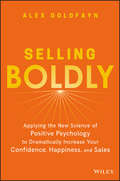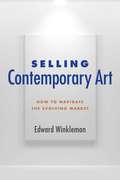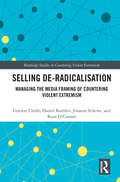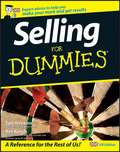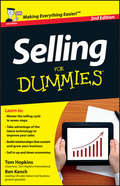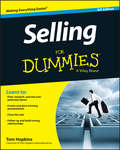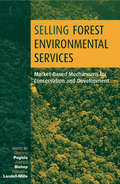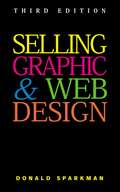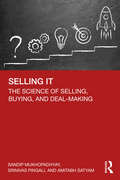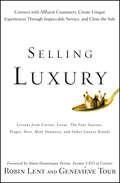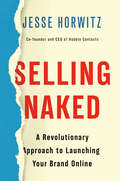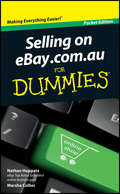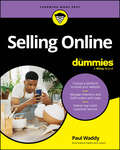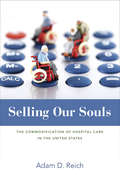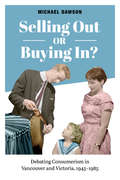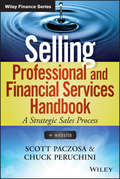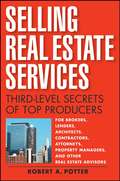- Table View
- List View
Selling Boldly: Applying the New Science of Positive Psychology to Dramatically Increase Your Confidence, Happiness, and Sales
by Alex GoldfaynIF YOU’RE IN SALES, FEAR HAS COST YOU MILLIONS OF DOLLARS, AND THIS BOOK IS FOR YOU. Fear is the reason most salespeople don’t like to pick up the phone (salespeople average just four hours per week on the phone, and our job is to talk to humans!). Fear is the reason we don’t ask for the business more, even though our customers want to buy from us. Fear is the reason we don’t offer our customers additional products and services, even though they would love to buy more from us. This book deals with that fear. You will learn exactly how to overcome this destructive fear in sales, and replace it with confidence, optimism, gratitude, joy, and proactive sales work. These are the powerful principles in the new field of positive psychology which are transforming how we work and succeed. Selling Boldly is the first book that leverages positive psychology to help you sell more. You’ll also learn a series of fast, simple sales-growth techniques—like how to add on to existing orders; and how to close 20% more quotes and proposals instantly; and how to properly ask for and receive referrals—that will grow your sales…dramatically and quickly. Alex Goldfayn’s clients grow their sales by 10-20% annually, every year, as long as they apply his simple approaches. IF YOU’RE IN SALES, FEAR HAS COST YOU MILLIONS OF DOLLARS, AND THIS BOOK IS FOR YOU. Fear is the reason most salespeople don’t like to pick up the phone (salespeople average just four hours per week on the phone, and our job is to talk to humans!). Fear is the reason we don’t ask for the business more, even though our customers want to buy from us. Fear is the reason we don’t offer our customers additional products and services, even though they would love to
Selling Contemporary Art: How to Navigate the Evolving Market
by Edward WinklemanA sophisticated examination of today’s contemporary art market from an art dealer’s point of view, this new book focuses on recent changes in the quickly evolving market. With an emphasis on how the market responded to the global recession that began in 2008, gallery owner Edward Winkleman moves from an examination of the factors beyond the individual dealer’s command to those that the dealer can control. Sections cover: The rise of the art fair The rise of the mega gallery New online competition Models of post-brick-and-mortar art dealing Art dealers as art fair organizers Collaboration in a new era Coverage is also given to the specifics of contracts contemporary art dealers may need, including an examination of a variety of contracts for representation, consignment, and new forms of contemporary art. Exhibiting a wide range of interviews with international experts including dealers, collectors, art-fair directors, journalists, and online art entrepreneurs, Selling Contemporary Art is a must-read for gallery owners, dealers, and artists affected by the rapid innovations in the art-dealing industry.
Selling Continuously: Paid to Think
by David GoldsmithYou sell all day every day ... to your board members, front-line staff, vendors, lenders, public, customers, colleagues, significant others, and more in order to realize the types of successes your organization depends on you to achieve. Yet, selling for the leader is much different than it is for the salesperson of goods and services, and that means you need to add a different set of skills and tools, such as those provided here, to gain buy-in and cooperation from others and to reach your desired outcomes.
Selling De-Radicalisation: Managing the Media Framing of Countering Violent Extremism (Routledge Studies in Countering Violent Extremism)
by Gordon Clubb Daniel Koehler Jonatan Schewe Ryan O'ConnorThis book examines how de-radicalisation programmes have been portrayed in the media and details the role of public relations (PR) strategies employed by such programmes and Countering Violent Extremism (CVE) to create positive coverage of their work. CVE and de-radicalisation programmes have seen a significant rise in recent years and are now cornerstones of many countries’ counterterrorism strategies. Despite the increased importance of these tools to counter violent radicalisation leading to terrorism, they remain controversial and sometimes receive fierce public criticism and opposition. This work looks at how CVE and de-radicalisation programs are able to influence a country’s discourse on de-radicalisation, and how far governmental programs differ from non-governmental initiatives in terms of their PR strategies. The book also provides a theoretical basis of how the discourse on CVE is constructed in the media. As major case studies, this book examines the United Kingdom, Germany and Nigeria. For these countries, the authors have gathered and assessed roughly 3,000 newspaper articles on de-radicalisation programmes over a decade to provide an empirical base. This book will be of much interest to students of countering violent extremism, de-radicalisation, and terrorism studies.
Selling Digital Music, Formatting Culture
by Jeremy Wade MorrisSelling Digital Music, Formatting Culture documents the transition of recorded music on CDs to music as digital files on computers. More than two decades after the first digital music files began circulating in online archives and playing through new software media players, we have yet to fully internalize the cultural and aesthetic consequences of these shifts. Tracing the emergence of what Jeremy Wade Morris calls the "digital music commodity," Selling Digital Music, Formatting Culture considers how a conflicted assemblage of technologies, users, and industries helped reformat popular music's meanings and uses. Through case studies of five key technologies--Winamp, metadata, Napster, iTunes, and cloud computing--this book explores how music listeners gradually came to understand computers and digital files as suitable replacements for their stereos and CD. Morris connects industrial production, popular culture, technology, and commerce in a narrative involving the aesthetics of music and computers, and the labor of producers and everyday users, as well as the value that listeners make and take from digital objects and cultural goods. Above all, Selling Digital Music, Formatting Culture is a sounding out of music's encounters with the interfaces, metadata, and algorithms of digital culture and of why the shifting form of the music commodity matters for the music and other media we love.
Selling For Dummies
by Hopkins Ben KenchBeing a successful salesperson isn't only useful in a traditional sales role. Whether you want to sell a new product to a business, an idea to an investor, or yourself in an interview, this book provides you with all the tips and techniques you need to stand out from the crowd. This straight-talking guide helps you develop the sales, communication, and negotiating skills you need to deliver successful presentations, win and retain customers, maintain your confidence, and get the results you want.
Selling For Dummies
by Ben KenchGet a handle on the most up–to–date selling strategies and techniques that will help you grow your business. Are you looking to enter the world of sales, or are you looking for new tips and tactics to expand your business? Selling For Dummies gives you the latest information on how to research your prospects, master the steps of the sales process, follow up with happy customers, and much more. This straight–talking guide helps you develop the sales, communication, and negotiating skills you need to deliver successful presentations, win and retain customers, and get the results you want. Discover what selling is - and isn′t! Find out how knowing your clients sets you apart from the rest and helps you get to ‘yes’ Use the seven steps of the selling cycle to score appointments, make a good impression, give winning presentations, address client concerns, close sales and more Get valuable tips on how to follow up and build a long-term relationship with clients Learn how you can sell well in any economy
Selling For Dummies
by HopkinsYour hands-on guide to the most up-to-date selling strategies and techniquesAre you looking to enter the world of sales, or are you already a salesperson who's looking for new tips and tactics to expand your business? No matter your level of skill, this guide will help you lay a foundation for sales success, with the latest information on how to research your prospects, break down the steps of the sales process, follow up with happy customers, and much more.The wonderful world of selling -- discover what selling is (and isn't) and find out how mastering selling skills can benefit all areas of your lifeStand out from the crowd -- find out how knowing your clients sets you apart from average persuaders and helps you hear more yesesScale the steps to success -- discover the seven steps of the selling cycle to score appointments, make a good impression, give winning presentations, address client concerns, close sales,and moreIf you build it, they will come -- take your career to the next level with valuable tips on how to stay in touch with clients, harness the power of the Internet to make more sales, manage your time wisely, and partner with othersOpen the book and find:Tips for approaching selling with passion and a positive attitudeThe latest prospecting and qualification strategiesTop techniques for sales presentationsHelpful hints on handling client concernsGuidance on getting referralsThe scoop on using the latest technology to your advantageInformation on establishing goals and planning your time efficientlyAdvice on staying upbeat when you don't succeedLearn to:Be truly well-prepared for every selling situation you encounter or createClose sales in seven steps or lessTake advantage of the latest technology during the selling processSet and achieve sales goals to grow your business
Selling Forest Environmental Services: Market-Based Mechanisms for Conservation and Development
by Joshua Bishop Stefano Pagiola Natasha Landell-MillsThe risks posed by forest destruction throughout the world are highly significant for all. Not only are forests a critical source of timber and non-timber forest products, but they provide environmental services that are the basis of life on Earth. However, only rarely do beneficiaries pay for the goods and services they experience, and there are severe consequences as a result for the poor and for the forests themselves. It has proved difficult to translate the theory of market-based approaches into practice. Based on extensive research and case studies of biodiversity conservation, watershed protected and carbon sequestration, this book demonstrates how payment systems can be established in practice, their effectiveness and their implications for the poor.
Selling Free Enterprise: The Business Assault on Labor and Liberalism, 1945-60
by Elizabeth A. Fones-WolfExplores the following topic: PART 1 The Postwar Employer Counteroffensive PART 2 In the Factory PART 3 In the Community PART 4 Institutions PART 5 After the Merger
Selling Graphic and Web Design
by Donald SparkmanExpert guidance on selling graphic design, in print and online. Attract today's savvy design clients! A veteran designer who turned his small business into a multimillion-dollar new-media company shares his strategies for success in this new edition of the acclaimed Selling Graphic and Web Design. Donald Sparkman's approach blurs the lines between graphic design, web design, and marketing by building strategic partnerships and thinking outside the box. No-nonsense advice for writing proposals and offering the right design solutions, plus information on providing services that fit a client's needs and budget, have made this book indispensable. Now, in this revised and expanded version, leading Internet designers share strategies on effective marketing for the web, including pricing, billing, portfolios, ethics, brand design, web content management, brand law, and much more. Trusted advice and the latest strategies combine to make Selling Graphic and Web Design a great one-stop resource for designers in every field. New edition of a classic Up-to-the-minute advice on selling to internet clients Get the top clients and keep them
Selling IT: The Science of Selling, Buying, and Deal-Making
by Amitabh Satyam Sandip Mukhopadhyay Srinivas PingaliInformation technology (IT) is an essential core of the economy today. Corporations and governments worldwide rely on it to drive their core strategy and develop and execute business models. Amounting to over 3.7 trillion US dollars of worldwide spending, the growing significance of the IT industry in the global economy is now well established. Hence, it is crucial to understand the marketplace within which it exists, and this book presents a systematic analysis of the processes, techniques, and methods involved in IT sales and marketing. In Selling IT, the book: Integrates a large IT provider’s selling process with the enterprise user’s IT buying process to highlight the nuances of selling, marketing, and developing IT solutions that create value for customers. Discusses various key concepts such as value-based IT selling, business case for IT acquisition, vendor evaluation and management, account and customer relationship management, customer segmentation, and techniques for customer acquisition and retention. Analyses the challenges and opportunities involved in selling digital IT and examines the evolution of jobs and careers based on the changed IT landscape. Includes lesson plans, case studies, and chapter-wise practice questions to support teaching and learning. The book boasts a robust theoretical foundation supported by a clear exposition of concepts and management theories. It will be of benefit to professionals using organisation-mandated selling processes. Young executives with a technology background looking for a sales and marketing career in the IT industry can also effectively use this book. It will also be an essential read for scholars and researchers in B2B marketing, IT consulting, technology sales, and digital transformation.
Selling Local: Why Local Food Movements Matter
by James Robert Farmer Jennifer Meta RobinsonIn an era bustling with international trade and people on the move, why has local food become increasingly important? How does a community benefit from growing and buying its own produce, rather than eating food sown and harvested by outsiders? Selling Local is an indispensable guide to community-based food movements, showcasing the broad appeal and impact of farmers’ markets, community supported agriculture programs, and food hubs, which combine produce from small farms into quantities large enough for institutions like schools and restaurants. After decades of wanting food in greater quantities, cheaper, and standardized, Americans now increasingly look for quality and crafting. Grocery giants have responded by offering "simple" and "organic" food displayed in folksy crates with seals of organizational approval, while only blocks away a farmer may drop his tailgate on a pickup full of freshly picked sweet corn. At the same time, easy-up umbrellas are likely to unfurl over multi-generational farmers’ markets once or twice a week in any given city or town. Drawing on prodigious fieldwork and research, experts Jennifer Meta Robinson and James Robert Farmer unlock the passion for and promise of local food movements, show us how they unfold practically in towns and on farms, and make a persuasive argument for how much they deeply matter to all of us.
Selling Luxury
by Robin Lent Genevieve Tour Alain-Dominique PerrinWhat does it take to sell high-end luxury creations to the richest clients in the world? In Selling Luxury, Robin Lent and Genevieve Tour, with thirty years of combined experience, share their savoir-faire. You'll also pick up tips from multi-million dollar luxury sales professionals who will help you understand the complexities of the universe of luxury. Selling Luxury will show you how a salesperson can acquire Sales Ambassador status by offering the impeccable service associated with the world's most prestigious brands.
Selling Modernity: Advertising in Twentieth-Century Germany
by S. Jonathan Wiesen Pamela E. Swett Jonathan R. ZatlinThe sheer intensity and violence of Germany's twentieth century--through the end of an empire, two world wars, two democracies, and two dictatorships--provide a unique opportunity to assess the power and endurance of commercial imagery in the most extreme circumstances. Selling Modernity places advertising and advertisements in this tumultuous historical setting, exploring such themes as the relationship between advertising and propaganda in Nazi Germany, the influence of the United States on German advertising, the use of advertising to promote mass consumption in West Germany, and the ideological uses and eventual prohibition of advertising in East Germany. While the essays are informed by the burgeoning literature on consumer society, Selling Modernity focuses on the actors who had the greatest stake in successful merchandising: company managers, advertising executives, copywriters, graphic artists, market researchers, and salespeople, all of whom helped shape the depiction of a company's products, reputation, and visions of modern life. The contributors consider topics ranging from critiques of capitalism triggered by the growth of advertising in the 1890s to the racial politics of Coca-Cola's marketing strategies during the Nazi era, and from the post-1945 career of an erotica entrepreneur to a federal anti-drug campaign in West Germany. Whether analyzing the growing fascination with racialized discourse reflected in early-twentieth-century professional advertising journals or the postwar efforts of Lufthansa to lure holiday and business travelers back to a country associated with mass murder, the contributors reveal advertising's central role in debates about German culture, business, politics, and society. Contributors. Shelley Baranowski, Greg Castillo, Victoria de Grazia, Guillaume de Syon, Holm Friebe, Rainer Gries, Elizabeth Heineman, Michael Imort, Anne Kaminsky, Kevin Repp , Corey Ross, Jeff Schutts, Robert P. Stephens, Pamela E. Swett, S. Jonathan Wiesen, Jonathan R. Zatlin
Selling Naked: A Revolutionary Approach to Launching Your Brand Online
by Jesse Horwitz&“A candid, behind-the-scenes look at how successful direct-to-consumer brands such as Hubble are launching their businesses on platforms like Facebook and Google.&”—Lisa Sherman, president and CEO, the Ad Council &“A must-read for anyone interested in starting a new business.&”—Moiz Ali, CEO, Native E-commerce startups have exploded in the marketplace, selling merchandise and services directly to consumers, often through mobile phones. They skip the middlemen, avoid the lower margins of retail channels of distribution, strike deals directly with manufacturers and suppliers, and, in doing so, save consumers money. Among the companies that are part of this e-commerce revolution are Dollar Shave Club, Casper, Quip, Peloton, and Hubble Contacts. In Selling Naked, Hubble Contacts co-founder and co-CEO Jesse Horwitz shows entrepreneurs and enterprise companies alike precisely how to conceive, launch, and grow an e-commerce brand by using paid marketing social media channels. Horwitz shows entrepreneurs how to test consumer interest before spending a dime by placing mock ads on Facebook and other social media. Using this method, Hubble Contacts got an astonishing two thousand signups in four days, and as a result, raised $3.5 million in seed money. Hubble ran a second experiment to see if consumers would actually sign up for the service, which led to a second multimillion-dollar investment. Horwitz shows how startups can cut through the metrics bullshit to focus on the one metric that really matters; how to use third-party tools rather than build everything from scratch; and how to tell a great story to investors and frame your digital offering. In addition to running Hubble, Jesse Horwitz now works with established Fortune 500 enterprises to help build their e-commerce brands within the landscape of a larger retail environment. Selling Naked is the definitive playbook on how to start up a successful direct-to-consumer business.
Selling On eBay.com.au For Dummies
by Marsha Collier Nathan HuppatzClear the clutter and make some cash! Selling items on eBay.com.au is the perfect way to declutter your home and make some money in the process. But getting the best price for your items isn’t always a cinch. This book provides plenty of tips and tricks for improving your listings, using the most suitable (and cost-effective) shipping methods, setting up an eBay store, using pictures to increase your profits, and finding more goods to sell.
Selling Online For Dummies
by Paul WaddyTransform your ecommerce ideas into profitable reality with this page-turning new handbook Online shopping is more popular than ever, and ecommerce is now a multi-billion-dollar industry. Isn’t it time for you to claim your share? If you’ve been wondering how to start an online business, or get your current business thriving online, this comprehensive guide shares everything you need to know. In Selling Online For Dummies, ecommerce advisor and online shopping guru Paul Waddy shows you exactly how to get started in setting up your online shop. With an expert’s eye for business, and an easy-to-understand take on the technical stuff, Waddy takes you from digital start to finish as he discusses topics like: Finding hot products to sell, working with suppliers and managing your inventory Building a website from scratch by choosing the right developer and platform Marketing your site with smart SEO, paid ads, and organic marketing strategies on Google, Instagram, Facebook and TikTok Understanding the user experience and creating happy, loyal customers Dealing with payments, currencies, taxes and duties It’s time to take advantage of the commercial opportunities waiting for you online. Selling Online For Dummies is a must-read that will help you turn your great idea from virtual to reality.
Selling Our Souls: The Commodification of Hospital Care in the United States
by Adam Dalton ReichHealth care costs make up nearly a fifth of U.S. gross domestic product, but health care is a peculiar thing to buy and sell. Both a scarce resource and a basic need, it involves physical and emotional vulnerability and at the same time it operates as big business. Patients have little choice but to trust those who provide them care, but even those providers confront a great deal of medical uncertainty about the services they offer. Selling Our Souls looks at the contradictions inherent in one particular health care market—hospital care. Based on extensive interviews and observations across the three hospitals of one California city, the book explores the tensions embedded in the market for hospital care, how different hospitals manage these tensions, the historical trajectories driving disparities in contemporary hospital practice, and the perils and possibilities of various models of care.As Adam Reich shows, the book's three featured hospitals could not be more different in background or contemporary practice. PubliCare was founded in the late nineteenth century as an almshouse in order to address the needs of the destitute. HolyCare was founded by an order of nuns in the mid-twentieth century, offering spiritual comfort to the paying patient. And GroupCare was founded in the late twentieth century to rationalize and economize care for middle-class patients and their employers. Reich explains how these legacies play out today in terms of the hospitals' different responses to similar market pressures, and the varieties of care that result.Selling Our Souls is an in-depth investigation into how hospital organizations and the people who work in them make sense of and respond to the modern health care market.
Selling Out a Superpower
by Ronald R. PollinaIn 1968, there were sixty-two lobbyists in Washington; today there are thirty-four thousand, outnumbering members of Congress and their staffers two to one. By 2008, these lobbyists were spending approximately $8.2 million for influence per day. Few, if any, of these lobbyists represent the majority of Americans in the middle class. So it's not surprising, given these statistics, that real median household income in America has stagnated for over a decade. This hard-hitting book documents that a combination of special interest groups and their army of money-peddling lobbyists, along with government mismanagement of business and the economy by both parties, have betrayed the American middle and lower classes for the last twenty years. The result is a host of misguided laws and policies that have driven jobs and whole industries offshore, never to return. The author takes issue with those who emphasize the potential benefits of globalization without taking notice of its many negative effects on American society. He also argues that inept policy threatens to derail the American economy permanently and that our economic malaise is more than a short-term reaction to a financial market collapse or global market forces. He cites critical areas where changes must be made to reverse the negative trend:* Improving our 1950s-era educational system to produce a workforce able to compete for 21st-century jobs.* Reform of tax codes that have been driving companies and jobs offshore. We are currently a nation that manufactures practically nothing!* Weaning all levels of government away from deficit spending, which drains economic power* Pursuing free trade that also means fair trade.* Ending the cycle of credit-card debt and all-too-easy mortgage credit to finance ultimately unaffordable lifestyles.* Making the United States more business friendly, so companies will grow and provide desperately needed jobs here at home.The author warns that unless we implement these and other recommended changes, the American economy will inevitably decline while China, India, and other up-and-coming nations ascend. He maintains that all is not lost. If we follow the course he sets, we can reinvigorate and renew our economy, rebuild America's greatness, create 21st-century jobs, and more. This book provides a roadmap for reclaiming American preeminence.
Selling Out or Buying In?: Debating Consumerism in Vancouver and Victoria, 1945-1985
by Michael DawsonUntil the late 1950s residents of Vancouver and Victoria negotiated a shopping landscape that would be unrecognizable to today’s consumers: most stores were closed for at least half the day on Wednesdays, prevented from opening during the evenings, and were banned from operating on Sundays. Since that decade, however, British Columbians, and Canadians generally, have made significant strides in gaining greater and easier access to consumer goods. Selling Out or Buying In? is the first work to illuminate the process by which consumers’ access to goods and services was liberalized and deregulated in Canada in the second half of the twentieth century. Michael Dawson’s engagingly written and detailed exploration of the debates amongst everyday citizens and politicians regarding the pros and cons of expanding shopping opportunities, challenges the assumption of inevitability surrounding Canada’s emergence as a consumer society. The expansion of store hours was a highly contested and contingent development that pitted employees, owners and regulators against one another. Dawson’s nuanced analysis of archival and newspaper sources reveals the strains that modern capitalism imparted upon the accepted and established rhythms of daily life.
Selling Paris: Property and Commercial Culture in the Fin-de-siècle Capital
by Alexia M. YatesBesieged during the Franco-Prussian War, its buildings damaged, its finances mired in debt, Paris was a city in crisis. Alexia Yates chronicles the private actors and networks, practices and politics, that spurred the largest building boom of the nineteenth century, turning city-making into big business in the French capital.
Selling Power: Economics, Policy, and Electric Utilities Before 1940
by John L. NeufeldWe remember Thomas Edison as the inventor of the incandescent light bulb, but he deserves credit for something much larger, an even more singular invention that profoundly changed the way the world works: the modern electric utility industry. Edison's light bulb was the first to work within a system where a utility generated electricity and distributed it to customers for lighting. The story of how electric utilities went within one generation from prototype to an indispensable part of most Americans' lives is a story about the relationships between political and technological change. John L. Neufeld offers a comprehensive historical treatment of the economics that shaped electric utilities. Compared with most industries, the organization of the electric utility industry is not--and cannot be--economically efficient. Most industries are kept by law in a state of fair competition, but the capital necessary to start an electric company--generators, transmission and distribution systems, and land and buildings--is so substantial that few companies can enter the market and compete. Therefore, the natural state of the electric utility industry since its inception has been a monopoly subject to government oversight. These characteristics of electric utilities--and electricity's importance--have created over time sharp political controversies, and changing public policies have dramatically changed the industry's structure to an extent matched by few other industries. Neufeld outlines the struggles that shaped the industry's development, and shows how the experience of electric utilities provides insight into the design of economic institutions, including today's new large-scale markets.
Selling Professional and Financial Services Handbook + Website
by Scott Paczosa Chuck PeruchiniAn effective strategic framework for successful face-to-face selling for financial services industry professionalsTimes are very tough for people who sell professional services and Selling Professional and Financial Services Handbook offers a new solution proven in practice. The book describes methods the authors have used and taught since the 1990s, most recently at a major consulting firm, where they led a Global Business Development team to revenue gains of 500% over six years -- in a period that included the recession of 2008-10.The solution is not any new twist on face-to-face selling techniques or the art of persuasion. It's a strategic approach built around a simple fact: the markets are tight but far from static. Even with lean budgets, client companies must respond to urgent changes and emerging threats in their industries. Thus they will buy services from the sellers who can help them detect, understand, and cope with what's coming their way.This handbook outlines a systematic way of becoming such a valued resource. Readers learn to scan the horizon for early signs of "rock-ripple events." Major changes in the business world often spring from new developments that are little noted or heeded, at first, by the client companies soon to be affected by them. But like a rock dropped in a pond, these events set off ripples that sweep through entire industry sectors, creating must-have service needs.The book is written for everyone who sells, or is responsible for selling, professional services. This includes but is not limited to: law firms, consulting firms, finance industry, public relations, engineering, and architectural services.Readers who can benefit from the dynamic approach hold a variety of positions. They include:Attorneys, consultants and other practitioners who must sell their services as well as execute.CEOs, equity partners, practice-area leaders, functional and divisional leadersPrivate Equity or Venture Capital executivesSales or business-development professionals, from entry level to senior levelSales and marketing managersBut the book is for sellers in every category who need a new and better approach to selling. Many, even the most skilled, simply have not adjusted to the new normal of today's economy. They persist with old strategies that cannot be as productive as they once were, such as pursuing one-off opportunities (which are too few and too hard to win in lean times) or old-style "relationship selling" (which gains little if any traction). Selling Professional and Financial Services Handbook gives all such readers a new strategic framework within which to apply their face-to-face selling skills. It is an approach that puts them in position to win -- so they can sell from ahead of the game, instead of struggling to keep up with it.
Selling Real Estate Services
by Robert A PotterPraise for Selling Real Estate Services"Selling Real Estate Services shows you how to stop being a vendor and start being a partner. Bob Potter's Third-Level concept will help you win more, have more fun, and build greater client loyalty. It's a playbook for success."--Roger T. Staubach, Executive Chairman for the Americas, Jones Lang LaSalle, and founder of The Staubach Company"It's not just about selling; it's about winning. Just in time for one of the most competitive markets in a generation. Be prepared to win."--Robert A. Ortiz, Executive Managing Director - U.S. Operations, Cushman & Wakefield Inc."Bob Potter's Third-Level Selling offers a progressive, advanced approach to building trust, demonstrating value, and winning. Whether you are new to real estate or a seasoned veteran, it will take your career to the next level."--Craig Robbins, Chief Knowledge Officer, Colliers International"Business development never stops for successful real estate companies. Bob Potter gets it, and his simple strategies and techniques can be implemented immediately across a sales-oriented organization. This book is a gem."--Tom Donnelly, President and COO, ValleyCrest Landscape Development"Rarely do books capture the essence of success in our industry. Third-Level Selling helps one understand how you build long-term committed relationships with clients. This book is a road map to becoming a top producer; I only hope that my competition doesn't read it!"--Dan Winey, Managing Principal, Gensler
